Many of you have read about our three days spent at the Home Orchard Society Fruit Tree Pruning class. One of the things we took home from the class, other than the new-found knowledge of correctly pruning our fruit trees, was Mason Bees. We have had them stored in the fridge for the last month waiting for the weather to warm up enough to put out their little houses, and yesterday we decided it was time.
Mason Bees are a common species of bee that make little compartments of mud inside existing insect holes usually in trees, logs, sticks, etc. The species of our bees are Blue Orchard Mason Bee, Osmia lignaria propinqua. The Mason Bees are great for pollinating, but unlike honey bees they live alone and every female makes her own nest, commonly referred to as a nesting tube. This makes them much easier to care for as there is no hive to manage. We just put little Mason Bee homes out and when they emerge in spring they will mate and the females will occupy the tubes we provided close by. The male Mason Bees die shortly after; how nice.
The female Mason Bee has a stinger but will not sting unless she is squeezed, while the male Mason Bee does not have a stinger at all. Mason Bees also don’t share the same diseases and parasites that honey bees do, which is great because it sure seems like those poor honeybees are having a hard time these last few years. Another wonderful characteristic is the Mason Bees land directly on the flower stigma, while honey bees typically land on the petal. This make Mason Bees more effective pollinators. You go little Mason Bees!!
When we ordered our bees, we got a handful of tubes with Mason Bees hibernating in them, and then we purchased a lot of empty tubes to build the rest of the Mason Bee home. By doing this we are adding nesting tubes for the growing colony of bees we are expecting, God willing.
Here it is below,
We took the little cardboard tubes, which were 12″ long, and folded them in half. We then inserted these into the PVC pipe half way in, adding as many as we could until they were all packed in there nice and tight. We then repeated the same process on the other end of the PVC pipe. So, this PVC Mason Bee home has potential nesting spots on both ends of the pipe. As you can see, the pipe was cut at an angle to provide a little roof over the opening to their home. If you look closely you can see the tubes in the bottom left are plugged with mud; these are the tubes containing the hibernating Mason Bees.
Here are the cardboard tubes we inserted in to the PVC home, before and after folding.
Hopefully we will start to see the Mason Bees emerging soon and doing their magic in our orchard.
Have a great day,
Michael
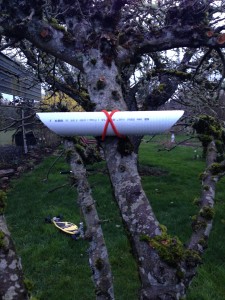
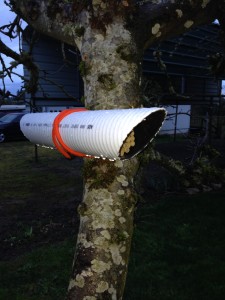
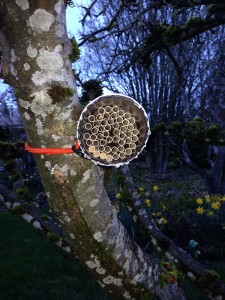
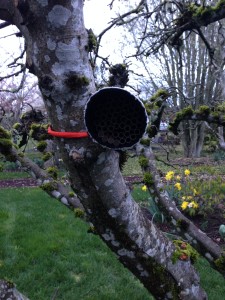
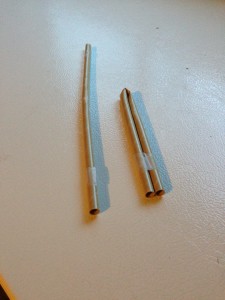
So important to help the species that are struggling. I too have Mason bee homes, although different material and shape but same purpose. But I have to wait until I get a home to put out the bee homes so will be to late for me this summer. Will you update the process and your success with your bees this year? Have you considered putting up Barn Owl boxes on your property? You have enough to keep the boxes on private property and protect them. Such a great process to watch, if you can manage to get up in the wee hours and quietly observe. They will reduce the rodent population on your property and adjoining neighbors. Most important is no use of Rodent bait or poison. Best of luck with all your animals.
Thanks Dee. We are pretty excited about having bees of any sort. We will soon be tossing some wild flower seeds in part of the orchard in hopes of bringing more bees to the homestead. I would LOVE to have a honey bee hive some day but that needs to wait as there is a TON of other stuff we need to learn about this new life of ours. I purchase raw local honey from a local couple but they are retiring. She said you could easily manage five hives without having to invest in expensive equipment. I go through about a quart a month so it would be nice to have our own someday. Yes, we will be updating on the Mason Bees.
I like the idea of Barn Owl boxes. As long as the owls leave my chickens alone. We have rodents and I’ve never seen an owl in person before so that would be very cool.
Take care,
Karen
I don’t remember if your chickens are free ranging? Or confined especially at night. The owls would be hunting at night. I only saw rats/field mice and part of road kill rabbit brought in by my Barn owls. Now the hawks, crows and the big jays will be a threat to chicks, baby ducks, etc. for sure. All of them are out and hunting/foraging at the same time. And be sure to google praying mantis so you can identify their egg sac and not mistakenly destroy them. They are wonderful insects to watch and share the yard/garden with each year. Such fun.
Our chickens are closed up at night so that wouldn’t be a problem. We do have birds of prey daily overhead. Most of the baby geese last year were taken by a red tailed hawk.
I’m not sure we have praying mantis in our area. I’ll have to check that out.
Thanx for the tips,
Karen
Yes, look for the praying mantis. They are here in the Willamette Valley. Some of the larger nurseries should sell the egg sacs to attach to you shrubbery to hatch….but try to watch so there aren’t any spider webs near by, the tiny babies get caught in the web and well…..you know….dinner for the spider. The mantis will stay in the general area where lady bugs really don’t…….they hatch and then take off. If you can get a few mantis up and going in the gardens (no spraying) they will provide egg sacs for the next year. I think their heart shaped faces are pretty and they are smart for insects.
I can’t believe I’m going to try to have praying mantis in my garden….or life for that matter.
The only time I have come face to face with one was in Bakersfield CA. I had just been transferred there (from San Diego County) and I was living in an apartment. I came home late one Friday night and there was one in my apartment. Not being overly fond of bugs I wanted it out. It was so big I just couldn’t kill it so I stood at my open door and waited for someone to walk by and then asked them to come in and get rid of it.
How much I’ve changed in those twenty years!
You won’t be sorry. In fact I bet you learn to love them too. And maybe take a look at the ‘walking sticks’ for your boys, can raise them in a large terrarium (covered)……so interesting.
I’ve only seen the stick bugs in books. I’ll have to figure out where to get eggs or live bugs and see if they want to have some. I could be opening myself up to some pranks from my boys though.
Wow! Those Mason Bees are fascinating.
I used to be a beekeeper, as once we moved to the farm, I wanted to do our part to preserve the North American Honeybee. But here, they had to be treated four times a year with sulphur strips to protect them from the bee mite. Well, you know our lifestyle for over 20 years of living on the road, and I could not get anyone to watch my bees when we were absent for months at a time. So, I had to miss a couple of regular treatments, and one time we came home and my dear beehives had been wiped out by the bee mite. It broke my heart, because my bees were very friendly, and I loved them. Thank God that I know a local beekeeper, and gladly pay him for honey. I will look into Mason Bees. Good for you all, love you.
I really want honey bees since I use so much raw local honey. Plus, I do believe we need to do our part to help them.They are a lot more work but thankfully we don’t travel around like you and Mr. Stebbing. Speaking of which, will you be out our way anytime in the near future?
I saw something on the internet about a new type of honey bee hive. It is called a “flow hive” ( http://www.honeyflow.com/) and I believe it is out of Australia. It is a very easy way to get the honey out but you still have to do all the hive maintenance. That is very neat that you know how to take care of bees.
Love to you both,
Karen
Might be able to order online. It’s a great preschool or elementary school project. The male and female walking sticks look completely different. They are another interesting insect.
Very interesting post. Most folks don’t think about Mason bees.
Hi Leigh, I had never even heard of Mason Bees before we went to the fruit tree pruning class. It is nice to be able to do something now, without jumping all the way in with honey bee hives. We will see how these little guys do for us.
Thanks for commenting.
Michael
Wow this is so interesting! I haven’t heard of Mason Bees but am sure going to be checking them out. Thanks!
I’m glad you found it interesting. For me it is an easy way to house bees on our property. Some day I may figure out honey bees but until then these little bees are great.
Thanx
Karen